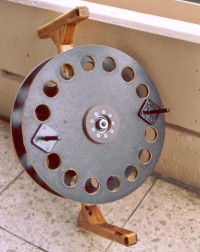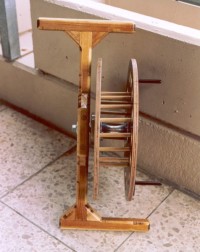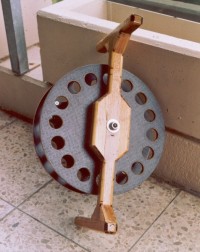by Karsten M. Schneymann, Germany
see bottom of page!
One of my first home-built kite line winding-devices was a design very close to the 'Deep Sky Reel' shown in 'The Penguin Book of KITES' by David Pelham. Since I didn't like to operate the reel just by slipping my hand through a webbing loop, so I changed the webbing for a kind of welded steel frame right away. Overall the design was pretty heavy for its size, but really sturdy too. Last winter (to be exact: late December 2006) I switched to a kite reel comparable to the one shown in the following. I built it as a birthday present for a kiting-friend in June 2005.
The basic design is well known: Two round wooden discs (with or without holes) and lengths of doweling glued in to form the core. I disliked the usual way of holding and operating the reel by means of grabbing a central handle inside the wide circular opening of the outer disc. Instead I had the idea of a two-handled 'frame' made from hardwood. This way I could use a bicycle spindle as an axle, like on my old sky reel.



Front view
The reel doesn't have revolving handles. It proved more reliable to have
lengths of steel rods welded on ground plates, which in turn are bolted
to the wooden disc.
A few days after I had given the reel to my kiting-friend I discovered,
that he had laid the reel flat on its 'face', so that the steel
rods stuck in the soft ground. "This way I don't need a ground stake
for my delta!" he explained with a grin.
Side view
You can see the bicycle spindle in the second picture. And the picture
discovers something, that later turned out to be a bad design fault. The
lengths of doweling are set up equally slightly tilted. I wanted to make the
empty reel look more interesting, especially when turned. But by doing this
and in addition of choosing the doweling diameter too thin, the core of the
reel has become too weak to withstand the pressure of kite line wound in
under tension. Every other day either a length of doweling pops out of its
drill holes, or another one simply breaks into pieces.
Now here comes the question: Will you ever see an empty kite reel turning
unless it is brand new?!?
Back view
The mounting of the bicycle hub is fairly easy, a centered drill hole is
all it takes (and of course washers and nuts). Note the reinforcement bars
glued to each side of the main arm to prevent breakage of the frame due to
the large drill hole for the axle.
